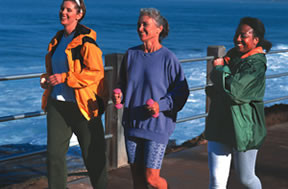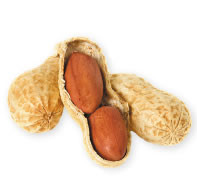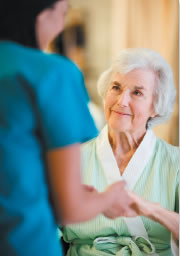
5 timeless habits for better health

What are the symptoms of prostate cancer?

Is your breakfast cereal healthy?

When pain signals an emergency: Symptoms you should never ignore

Does exercise give you energy?

Acupuncture for pain relief: How it works and what to expect

How to avoid jet lag: Tips for staying alert when you travel

Biofeedback therapy: How it works and how it can help relieve pain

Best vitamins and minerals for energy

Should you take probiotics with antibiotics?
Staying Healthy Archive
Articles
More evidence that exercise protects mobility
If you stay physically active in your older years, you're preserving your ability to keep moving. That's not just because you're exercising your heart and lungs and keeping your muscles and bones strong, but possibly also because you are warding off the effects of common age-related brain abnormalities called white matter hyperintensities (WMH)—small areas of damage in connections in the brain that are often related to long-term changes in the small blood vessels feeding the brain. High levels of WMH are associated with difficulty walking, but a study published in Neurology March 11, 2015, observed that older adults with WMH who were more physically active suffered less movement problems.
Researchers measured physical activity among 167 older adults with WMH. For the people who were the most active—in the top 10%—greater amounts of brain damage did not affect their scores on the movement tests. But for people who were half as active or less, more brain damage was associated with much lower scores on movement tests.
SMART ways to set core exercise goals
Strengthening your core offers big payoffs, including sports successes, a stronger lower back, independent living, and all-around fitness. Sounds great, right?
Even so, finding the time and will to do these exercises may not be easy. But experts say you're more likely to be successful if you set goals that are SMART — that is, specific, measurable, achievable, realistic, and time-based. So when you set a goal for your core workouts, make sure it passes the SMART test:
Easy-does-it jogging may lead to a longer life
In a study, people who took a leisurely jog just a few times a week lived longer than those who avoided jogging. The joggers who reaped the longevity benefit ran for a total of one to 2.5 hours per week at a pace of about 5 mph.
Good balance requires mental and physical fitness
Balance can't be taken for granted past a certain age; it must be maintained — both in mind and body.
General physical fitness and targeted exercises to improve balance can prevent falls. But so can staying mentally active to maintain brain health. A sharp mind helps you to think — and stay — on your feet.
Regular exercise reduces falls and fractures
Your bone strength and size peaks by age 30. After that, bones tend to become less dense, making them more fragile and subject to breaks. Bone strength in later life depends upon your peak bone mass in youth. An active lifestyle in youth can increase maximum bone density.
Even if you're older, exercise is still a great way to protect your bones. The physical stress placed on bones during exercise stimulates the growth of new bone tissue. The type of exercise you do matters. To bolster your bones, you need to get regular weight-bearing exercise. This includes weight lifting and resistance training, as well as any type of activity that forces you to work against gravity by standing or carrying your body's weight, including running, walking, dancing, and stair climbing. Activities such as swimming or biking aren't weight-bearing and thus don't build bone. Generally, higher-impact activities (such as running) or resistance exercises (such as strength training) have a more pronounced effect on bone than lower-impact exercises, such as walking.
Benefits of flexibility exercises
Activities that lengthen and stretch muscles can help you prevent injuries, back pain, and balance problems.
A well-stretched muscle more easily achieves its full range of motion. This improves athletic performance — imagine an easier, less restricted golf swing or tennis serve — and functional abilities, such as reaching, bending, or stooping during daily tasks. Stretching can also be a great way to get you moving in the morning or a way to relax after a long day. Activities such as yoga combine stretching and relaxation and also improve balance, a wonderful combination.
Are you really getting enough exercise?
Resistance machines can provide safe, effective strength training. Image: Thinkstock |
To get the full benefit of your workout, you need to know how hard you're exercising, and that can be different for everyone.
Personalized medicine sounds futuristic, but it's really about your relationship with your doctor
By Anne Fabiny, M.D., Editor in Chief
President Barack Obama recently announced the Precision Medicine Initiative, a new program to speed up discoveries based on information and technology stemming from the Human Genome Project. "Precision medicine" and "personalized medicine" are terms that describe health care tailored to an individual patient's genetic makeup, using information about a patient's genome to diagnose illness and design therapies to treat and cure disease. This approach has been described as "the medicine of the future."
However, it may be reassuring to know that although your doctor doesn't have your genome at hand, he or she is likely to be giving you personalized care as we understand it today.
Eating peanuts may extend your life
Health studies rarely involve people on opposite sides of the globe who have very different lifestyles. However, researchers at Vanderbilt Medical School took that approach when they pooled data from dietary studies of 72,000 men and women in the southeastern United States and 135,000 people in Shanghai, China. It turns out that the Americans and Chinese have something in common—they both eat a lot of peanuts—and they may be living longer as a result.
All of the participants filled out detailed questionnaires on the foods they ate regularly. The research team noted that peanuts accounted for 50% of nuts eaten by Americans and almost all the nuts consumed by the Chinese.
The dollars and sense of long-term care
Even if you feel you've saved enough money for the future, it's important to start planning for long-term care now, when you can make sound decisions. Images: Thinkstock |
Why you should plan now for care you may need later.

5 timeless habits for better health

What are the symptoms of prostate cancer?

Is your breakfast cereal healthy?

When pain signals an emergency: Symptoms you should never ignore

Does exercise give you energy?

Acupuncture for pain relief: How it works and what to expect

How to avoid jet lag: Tips for staying alert when you travel

Biofeedback therapy: How it works and how it can help relieve pain

Best vitamins and minerals for energy

Should you take probiotics with antibiotics?
Free Healthbeat Signup
Get the latest in health news delivered to your inbox!
Sign Up









